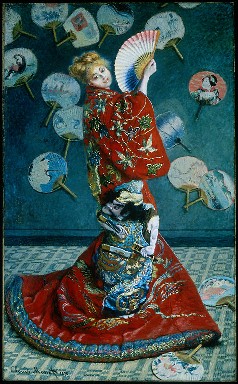| architecture |
| calligraphy |
| ceramics |
| clothing |
| comics |
| gardens |
| lacquerwork |
| literature |
| movies |
| music |
| painting |
| poetry |
| sculpture |
| tea ceremony |
| television |
| theatre |
| weaponry |
| thematic routes |
| timeline |
| the site |
context: painting > prints
Influence on the West

|
Japanese Girl, by Claude Monet |
Prints that no one wanted to buy started to be used as packing material for the ceramics that were fashionable in Europe, and suddenly the art was fashionable too. This was particularly so in Paris and among the impressionists. You can see Japanese prints on the walls in some paintings - Manet's portrait of Zola, and overtly in the Monet painting shown here.
The usual account is of these artists picking up odd cropping and asymmetrical composition (Degas is top of the list there), boldness of line and outline (Van Gogh, Gauguin) and simplifying form for pictorial reasons. I'm not arguing with any of that, but there are more connections than that, and I'd need more convincing evidence of timing (did many prints get out before the Meiji Restoration? I suspect not, which would mean end of the 1860s as the earliest any would have reached Paris) to guess whether these were also effects of the influence of Japanese prints, or perhaps reasons why the Impressionists felt in tune with them:
- Both depicted the pleasure quarters of their big cities.
- Both painted the stage performers of their cities.
- Both had links to controversial literary/political figures (I realise that Cezanne's and Manet's links to Zola far predate his celebrity).
- Both showed an unusual interest in depicting ordinary people doing ordinary jobs.
- Both were to some extent reacting against established, academic norms.
- Both showed a reverence for nature.
Frankly, one can make parallels between individual artists too, but it's all nonsense. I think what it amounts to is that there was a brief Japonisme fashion, some artists grasped how it opened up new options in some areas and ran with it, a bit. We can see the sophisticated understanding of the European artists in this quote from Van Gogh: "Isn't it almost a true religion that these simple Japanese teach us, who live in nature as if they themselves were flowers? And you cannot study Japanese art, it seems to me, without becoming much gayer and happier..."
I can't resist one sidebar piece, on...
Henri Riviere
And here is a superb blog on Japonisme.
